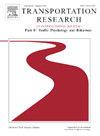How do design factors of stacked directional signs affect their visual cognition?
IF 3.5
2区 工程技术
Q1 PSYCHOLOGY, APPLIED
Transportation Research Part F-Traffic Psychology and Behaviour
Pub Date : 2024-10-18
DOI:10.1016/j.trf.2024.10.008
引用次数: 0
Abstract
Stacked directional signs are widely used on Chinese roads, but research on them is relatively scarce. This study aimed to investigate the effects of the Language used, Layout format, Amount of information, and use of Separating lines on the visual cognition of stacked directional signs. A visual cognition experiment involving thirty-two drivers was conducted, and the reaction time and response accuracy were recorded. The results revealed that a greater Amount of information was correlated with increased visual cognition reaction times. Bilingual signs exhibited significantly greater reaction times compared to monolingual counterparts, while a simpler Layout format resulted in shorter reaction times. The Language used, Amount of information, Layout format, and use of Separating lines were in decreasing order of importance for visual cognition reaction time, with a high Amount of information having the greatest effect. The implications of these findings can be applied to the design and optimisation of stacked directional signs.
堆叠式方向指示牌的设计因素如何影响他们的视觉认知?
堆叠式方向指示牌在中国道路上被广泛使用,但相关研究却相对较少。本研究旨在探讨叠加式方向指示牌所使用的语言、布局形式、信息量以及分隔线的使用对其视觉认知的影响。研究人员对 32 名驾驶员进行了视觉认知实验,并记录了他们的反应时间和反应准确性。结果显示,信息量越大,视觉认知反应时间越长。与单语标识相比,双语标识的反应时间明显更长,而更简单的布局形式则导致反应时间更短。所使用的语言、信息量、布局格式和分隔线的使用对视觉认知反应时间的影响依次递减,其中信息量大的影响最大。这些研究结果可用于设计和优化堆叠式方向指示牌。
本文章由计算机程序翻译,如有差异,请以英文原文为准。
求助全文
约1分钟内获得全文
求助全文
来源期刊
CiteScore
7.60
自引率
14.60%
发文量
239
审稿时长
71 days
期刊介绍:
Transportation Research Part F: Traffic Psychology and Behaviour focuses on the behavioural and psychological aspects of traffic and transport. The aim of the journal is to enhance theory development, improve the quality of empirical studies and to stimulate the application of research findings in practice. TRF provides a focus and a means of communication for the considerable amount of research activities that are now being carried out in this field. The journal provides a forum for transportation researchers, psychologists, ergonomists, engineers and policy-makers with an interest in traffic and transport psychology.

 求助内容:
求助内容: 应助结果提醒方式:
应助结果提醒方式:


